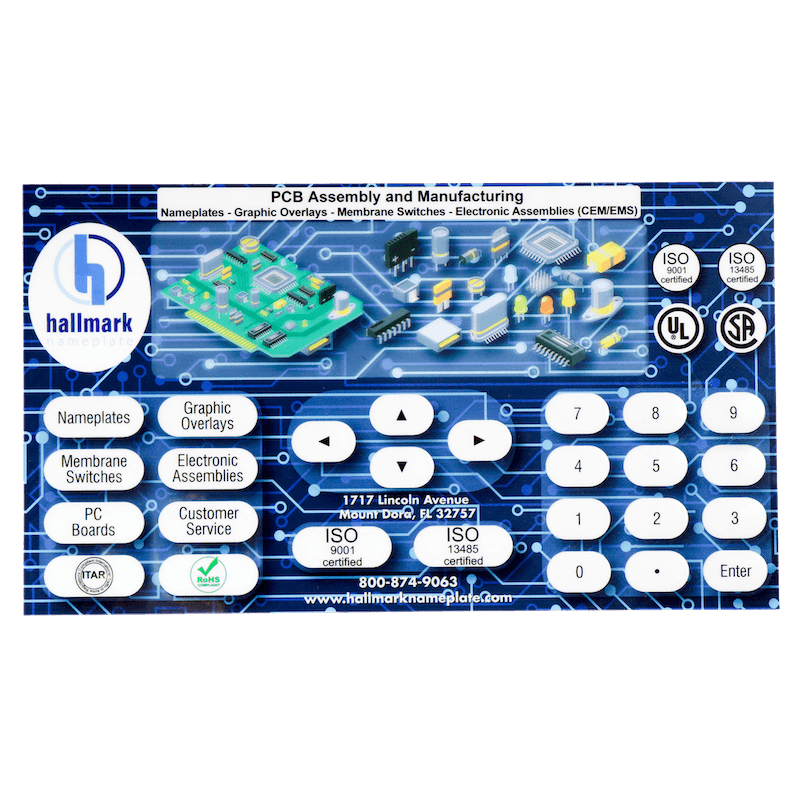The Role of Membrane Switches in Enhancing Device Functionality
The Role of Membrane Switches in Enhancing Device Functionality
Blog Article
Comprehending Membrane Changes: The Key to Sturdy and Trustworthy Controls

What Are Membrane Layer Buttons?
Membrane switches are an innovative solution in the realm of individual interface modern technology, incorporating functionality and style effortlessly. These tools function as an interface between users and electronic systems, incorporating numerous parts right into a portable layout. Generally created from adaptable, slim layers of products, membrane switches are created to react to touch, making it possible for customers to connect with equipment and digital tools efficiently.
The main aspects of a membrane layer switch include a printed circuit layer, visuals overlay, and a spacer layer that protects against unintended activation. The graphic overlay can be tailored to mirror brand name identification or customer preferences, improving aesthetics while ensuring use. Membrane layer buttons are commonly utilized in various applications, consisting of clinical devices, consumer electronics, and industrial equipment, owing to their resilience and resistance to ecological variables such as wetness and dust.
Among the essential advantages of membrane layer buttons is their capacity to endure damage, making them perfect for high-traffic environments. In addition, they are lightweight and require marginal area, permitting innovative layouts in product development. Generally, membrane layer switches over represent a effective and practical option for modern-day electronic user interfaces, marrying technology with user-centric style principles.
Just How Membrane Layer Switches Job
The procedure of membrane changes joints on an easy yet efficient device that translates individual input right into digital signals. When a user presses the switch, the top layer deforms, enabling a conductive component in the circuit layer to make call with a corresponding conductive pad on the underside of the visuals overlay.
The layout of membrane switches can vary, however they often incorporate domes or tactile components to supply responses to the individual, boosting the total experience - membrane switch. The products utilized in membrane layer buttons, such as polyester or polycarbonate, contribute to their sturdiness and resistance to ecological aspects, consisting of wetness and dirt. The printed circuits are usually enveloped, which secures them from wear and tear over time.
Advantages of Membrane Switches

Furthermore, membrane buttons are recognized for their longevity. Constructed from durable products, they are resistant to dirt, moisture, and physical wear, which significantly prolongs their life-span contrasted to traditional mechanical buttons. This sturdiness makes them particularly ideal for high-traffic environments and check these guys out applications requiring longevity.
Another substantial benefit is the simplicity of cleansing and upkeep. The smooth surface of membrane changes lessens dust build-up and is usually unsusceptible spills, making them perfect for settings that require constant sanitization.
In addition, membrane layer switches use a structured profile, resulting in a thinner design that can be incorporated right into numerous tools without including bulk. This feature not just boosts the aesthetic appeal but also adds to a much more ergonomic product design.
Applications of Membrane Layer Switches
Flexible and user-friendly, membrane layer switches locate applications throughout a broad variety of industries, consisting of clinical tools, consumer electronics, and industrial equipment. In the clinical field, these buttons are indispensable to gadgets such as analysis devices, client monitoring systems, and mixture pumps, where dependability and ease of cleansing are vital. important source Their ability to preserve and hold up against severe settings performance makes them perfect for such applications.

In consumer electronic devices, membrane switches are made use of in products like microwaves, cleaning makers, and remote controls - membrane switch. Their smooth layout enables instinctive user interfaces, improving the overall individual experience while giving sturdiness and resistance to tear and wear
Industrial tools also profits from membrane layer switches, particularly in control panels this for equipment and automation systems. These buttons supply protection against dirt and dampness, making certain regular efficiency in challenging environments. Moreover, their adjustable attributes permit manufacturers to tailor them to particular functional requirements, improving effectiveness and capability.
Choosing the Right Membrane Layer Switch
When selecting a membrane switch, it is vital to think about different aspects that influence performance and suitability for particular applications. The main considerations include ecological problems, tactile comments, toughness, and design specifications.
First, evaluate the operating atmosphere; switches exposed to wetness, chemicals, or severe temperature levels call for details products to guarantee longevity and capability. Next off, assess the need for responsive responses. Depending upon user communication, some applications may take advantage of a responsive action to verify activation, while others may like a non-tactile style for aesthetic factors.
Longevity is one more important element; membrane layer buttons should be made to stand up to regular usage, effects, and abrasion. Ensure the picked switch can endure the anticipated lifecycle, especially in high-usage circumstances.

Conclusion
In conclusion, membrane layer switches over serve as crucial elements in the layout of resilient and trusted control systems across different sectors. The versatility of membrane layer switches enables for customized solutions that meet certain functional needs, reinforcing their relevance in contemporary technology.
Membrane changes stand for a critical element of contemporary interface style, mixing capability with strength in various applications.Membrane switches are a sophisticated service in the world of customer interface modern technology, combining functionality and design perfectly. Normally created from versatile, slim layers of materials, membrane switches are developed to respond to touch, enabling users to communicate with machinery and electronic tools effectively.
The style of membrane layer buttons can differ, yet they typically include domes or responsive aspects to offer comments to the user, enhancing the overall experience.In verdict, membrane switches offer as crucial parts in the style of reputable and long lasting control systems across various industries.
Report this page